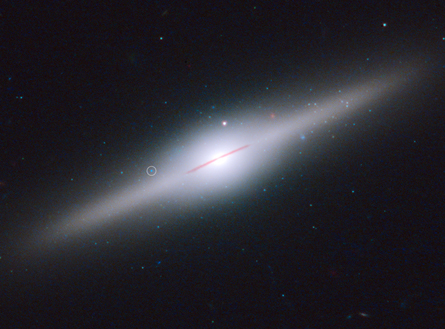BEIJING — A black hole about 290 million light-years away has just begun slurping material from its surroundings, an annual ritual revealed by a periodic brightening in X-ray wavelengths.

“It is picking up again, just today — or last night — which is good,” astronomer Roberto Soria of the International Center for Radio Astronomy Research in Perth, Australia, said August 22 at the 28th General Assembly of the International Astronomical Union. “I was starting to get a bit worried because this cycle was three or four days late.”
The black hole, known as HLX-1, is 10,000 times as massive as the sun and the only known specimen in its weight class. Middleweights like HLX-1, which should be numerous, are intermediate between the supermassive black holes at galactic cores — as massive as billions of suns — and the featherweights with just a few solar masses.
First detected by X-ray telescopes in 2009, HLX-1 has since been spied upon in visible wavelengths by the Hubble Space Telescope and other instruments. Those observations revealed a mysterious, bluish glow surrounding the object, which hovers above the plane of a distant galaxy. Now, scientists are trying to determine where the glow is coming from, how HLX-1 formed, and where the rest of the intermediate-mass black holes are hiding.
The most popular theory so far is that the glow is starlight, produced by a cluster of young, blue stars.
But young stars aren’t the only candidates. A different scenario implicates a debris field, or accretion disk, formed by the black hole’s annual feasting on a companion star.
“When the [light] was first discovered, it wasn’t clear whether it was a single star, an accretion disk, or a star cluster,” Soria said. “The issue is still not resolved.”
Soria prefers the accretion disk scenario, in which the light comes from a glowing disk formed by the material stolen from a small, companion star. Because the star’s orbit is elliptical, it comes close enough for HLX-1 to slurp some of the star’s mass about once a year. That material then spirals into the disk, creating a transient brightening. Astronomers see an X-ray brightening around the black hole every 366 days or so, presumably the result of this periodic nibbling.
Though that’s a plausible theory, there are some problems with it, said Sean Farrell, an astronomer at Australia’s Sydney Institute for Astronomy, whose observations produced the young star cluster theory.
“I think there is a disk component. We see it in the X-rays; we see it with other black holes,” he said. “The problem is, it’s not enough on its own. The light we see is too bright to be a single star. We think there has to be a cluster of young stars.”
Observing the system again using the Hubble Space Telescope should help resolve the issue, he said.
This class of black holes consisting entirely of HLX-1 was, until 2009, merely theoretical. What’s confounding is that intermediate mass black holes should be numerous, populating the middle ground between featherweight stellar-mass black holes and the supermassive cosmic drains around which galaxies swirl.
Farrell suggests they’re hard to see because most are invisible, stripped of the stars and gas that telescopes can spy on. He speculates that these middleweights are the remains of collapsed primordial stars. Eventually, some became the centers of dwarf galaxies. Then the dwarf galaxies collided, booting their middleweight seeds into space.
“They’ll be floating around in the halos of galaxies, which is exactly where we see this one,” Farrell said. “There could be hundreds of them in every Milky Way–sized galaxy.”







